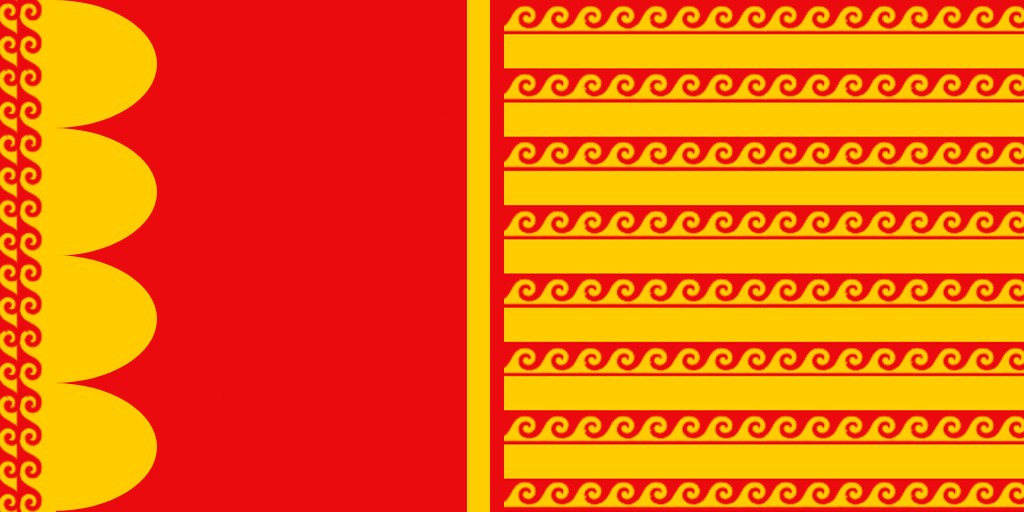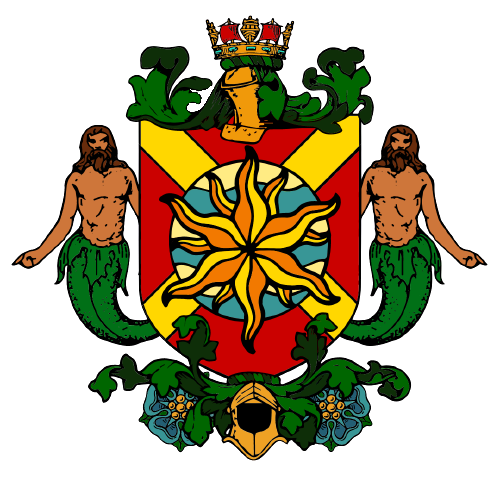Ajudige
Overview
|
Trex Reiuneux del'Ajudige The Three Kingdoms of Ajudige |
|
Flag of Ajudige |
|
Seal of Ajudige |
|
"De Ilax do Eternale Formosao" |
|
Motto "Iumeunitje i Amaoreu Sjeuprem Noix" |
|
Anthem: "De Misteriax del'Ajudige" The Secrets of the Ajudige |
|
Capital: Pjaia |
|
Official Language: Ajudigioux Minor Languages:
|
|
Demonym(s):
|
|
Nationality:
|
|
Religion:
|
|
Government: Constitutional Republic
|
|
Legislature: Parliament
|
|
Currency: Ajudigioux Peisa (₱) (APS) |
|
Timezone: UTC-9 (SLST) |
|
Population: 109,389 |
|
GPD: $9.375 Billion
|
|
Internet TLD: .aj |
|
ISO 3166 Code: AJ |
|
HDI: 0.915 (Very High) |
The Three Kingdoms of Ajudige (Ajudigioux: Trex Reiuneux del'Ajudige; Spanish: Tres Reinos de Adige) is an archipelagic country located in the San Luis region of the Creative 1.15 map. It is bordered on all sides by the San Luis Sea and has maritime borders with Cascadia to the west of the Island of Ajudige and the United Republic to the east of the Island of Sjearseu. It is the only country in the San Luis region where majority of its population is made up of indigenous peoples and is the only country where Ajudigioux is the official language with English and Spanish being common second languages amongst the population. Ajudige is a republic made up of 3 regions that were called Reiuneu (Kingdoms). These three kingdoms are the Reiuneu del'Ajudige, Reiuneu del'Sjearseu, and Reiuneu del'Baiepja. These three kingdoms is how Ajudige gets its official name. However, these three historic kingdoms have been split into five modern prefectures: Ajuruba, Diudi, Ajudige, Sjearseu, and Ilax del'Qjarao. Major population centers in Ajudige include Pjaia, Ajuruba, Cidadiu de'a Marex, Sao Fjroia, and Baxaio.
History
First Ancient Era (3000 B.C.E. - 0 C.E.)
Humans first arrived in Ajudige via a shallow land bridge sometime around 3000 B.C.E.. The early Ajudigioux shared a common ancestor with the Wendat, Choctaw, Gathawk, and Durbanian First Peoples. However, these ancient Ajudigioux followed a culture closer to that of the neolithic Qa peoples that inhabited the western forests of the San Luis Sea region. The ancient Ajudigioux were thought to have been drawn by the natural hot springs, fertile coastal plains, and sheltered bays of the landmass that they now inhabited. Small communities started to have been established around 2000 B.C.E. with many of the early settlements still being inhabited to the modern age, making Ajudigioux cities being some of the oldest in the world.
The Ajudigioux of the time were reliant on fishing, communal agriculture, and hunting of small game animals such as rabbits, squirrels, and prairie dogs. The food pallet of the Ajudigioux was mainly comprised of seafoods as meat from land animals was not always available and over hunting became an issue around 500 B.C.E. as a mass population drop in inland communities signifies.
The language of the people start to develop into its own unique language that is different from the Iroquois languages spoken by their ancestral relatives. Not many examples of ancient Ajudigioux survive to this day and not many elements of the ancient language has survived into the modern era. However, many places were named before colonization by the Spanish. Pjaia (Pa-aean), Diudi (Gdeu-gdee), and Sjerseau (Se-re'oo) are all of ancient Ajudigioux origin.
Some of the most notable aspect of the First Ancient Period is the pottery. Ajudigioux pottery was made out of clays and other earthen material compared to the woven baskets of their Iroquois cousins. Examples of this type of pottery show that details in the clay were from plants, mainly grasses and seasonal wildflowers, that were imprinted on the sides of pots and vases. It is believed that the imprints were purely for decoration but some evidence shows that the imprints were used as a way of storage categorization.
Second Ancient Era (0B.C.E. - 600 C.E.)
The Second Ancient Era was when the rise of Ajudige began. This era saw rapid advancements in technology as well as the first signs of boat building. By this time, Ajudige had become an island and was isolated from the mainland, now sparsely populated by other Iroquois tribes.
Seafaring became an integral part of the Ajudigioux culture of the time. This origins of Ajudigioux seafaring are from fishing and merchant trading between Ajudige and the mainland. Around 270 C.E., Ajudigioux started to settle the island of Sjerseau near what is now Sao Fjroia. This started a trend of Ajudigioux settlements being established around the San Luis Sea. This era saw the settling of the Ilax del'Qjarao (Qjarao Islands / Islas de Carraz) - formerly the Ilax del'Baiepja (Baiepja Islands / Islas de Bajepa); Western Ajudigioux settlements on the mainland in what is now Lennox Province, Cascadia; and Ajudigioux settlements in what is now Ellester, United Republic.
Due to the rapid expansion of Ajudigioux territory, Ajudige became a diverse group of people whose culture was introduced to other indigenous San Luisian peoples as well as adopting aspects of other regional cultures. Ajudige was the main dominant power in the region during this era for these reason and the legacy of this ancient past is reflected in the cultures of indigenous peoples in the San Luis Sea region in the modern era.
As each area grew in population, they began to form regional identities that were unique to each settlement. However, the origin of being Ajudigioux still remained regardless of distance from the original island. This is usually regarded as the first example of a sovereign country being established in this region, meaning it encapsulates many nations instead of one.
First Kingdoms Period (600 C.E.-1100 C.E.)
Due to the isolation each settlement faced, different groups within the Ajudigioux culture formed. Each grouping was called Qa-de'em, roughly translating to "United People Grouping" or "Kingdom". Each Qa-de'em had its own ruler and higher governing council. In the largest of these Qa-de'em, Ajudige, there were three subdivisions - A'a-de'eg (Ajudige), Gdeu-gdee (Diudi), and Aua-ruu'bu (Ajuruba) - to balance the power over different parts of the Qa-de'em.
During this era, there were five Qa-de'em: A'a-de'eg (Ajudige), Se-re'oo (Sjerseau), Ba'e-paa (Baiepja), Gda-oo (Gjadeu; Fort Kazanova, Cascadia), and Maraaq (Mara'aqe; Ellester, United Republic). Each one has its own idenity and cultural differences and acted as its own entity. However, A'a-de'eg served as the true center of the Ajudigioux world with Pa-aean (Pjaia) serving as the mecca of Ajudigioux people and culture.
With the Ajudigioux influence being widespread throughout the region, the largest settlements became hubs of activity, trade, and commerce. Pa-aean became the meeting point for all cultures within the central and northern San Luis region. This served as the second mass gathering place for festivals and worship following the gathering place near Montmorency.
In this period, we also saw the expansion of Ajudigioux art, specifically performing and oral arts. Most of the oral arts leading up to this period was similar to the drumming and chanting of their Cascadian and Durbanian cousins. However in this era, there was a deviation from group chanting and there was more solo works. This solo performance of singing and storytelling is called Qalara'a and was one of the first uniquely Ajudigioux music genres. Dances that accompanied Qalara'a started to develop shortly after as well.
TO BE CONTINUED
Geography
Ajudige is an archipelagic country located in the central San Luis Sea and in between Lennox Province, Cascadia and Bristol, United Republic. The nearest foreign lands to Ajudige is Fort Kazanova, Cascadia. Ajudige consists of 57 islands, islets, and rocks with the largest islands being Ajudige, Sjerseau, and Ajuruba. The Tallest point in Ajudige is Cacedrale Geminaix in Pjaia at __m (__ft) in elevation and the lowest point in the country being sea level. Majority of the country consists of rolling hills with gentle topographical relief with some exceptions being centered in areas with recent volcanic activity.
Almost all islands in Ajudige are of volcanic origin being mainly comprised of basalts, gabbro, and other mafic and intermediate rocks. The smaller islets of the country is formed form heavily lithified sandstones of organic compositions. Majority of the sandstone mined and used in Ajudige are formed from the compression of chemically eroded minerals like calcium and quart, corals, and invertebrates.



No Comments